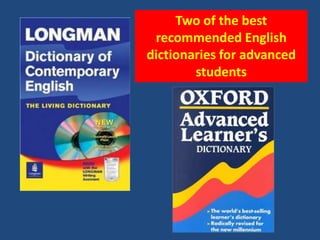Introduction to Translation
- 1. THE ART OF TRANSLATIONPrepaired by Dr. M. Fahmy Raiyah
- 2. CONTENTS • The Process of Translation Catford’s Definition of Translation Eugene Nida’s Model • Tools of the Translator Dictionaries Reference Works Relevant Material • Translation Levels The Lexical Level The Syntactic Level
- 4. Catford’s Definition of Translation Translation is the act of replacing text in the source language (SL) by an equivalent text in the target language (TL), where not only superficial semantic equivalents are sought but also a maximum of implied meanings and emotional effects are transferred.
- 5. Eugene Nida’s Model Source Language Target (Receptor) (SL) Language (TL) Analysis Synthesis Transfer
- 6. • Analysis (Decoding) • Transfer • Synthesis (Encoding or Re-structuring)
- 7. • Equivalence • Translation Losses
- 8. TOOLS OF THE TRANSLATOR
- 9. The translator must in good command of both the source and target languages. I addition, he needs the following tools of the trade: 1. DICTIONARIES 2. REFERENCE WORKS 3. OTHER WORKS IN THE FIELD OF THE SOURCE LANGUAGE TEXT TOOLS OF THE TRANSLATOR
- 10. 1. Dictionaries Unabridged Abridged Monolingual Bilingual paper electronic General vocabulary Usage and Idioms, etc
- 11. • Monolingual dictionaries Unabridged: o Oxford English Dictionary (OED) o Random House Dictionary of the English Language o American Heritage Dictionary of the English Language o Webster’s New International Dictionary Abridged: o Shorter Oxford English Dictionary o Oxford Concise Dictionary of English (COED) o Longman Dictionary of Contemporary English o Oxford Advanced Learner’s Dictionary
- 13. • Bilingual Dictionaries (English – Arabic & Arabic –English): o– o– o o o o o
- 15. Two of the best recommended English dictionaries for advanced students
- 16. • Dictionaries of Usage and Idioms
- 17. ELECTRONIC DICTIONARIES ONLINE COMPUTER-BASED SOFWARE HANDHELD
- 18. • Online Dictionaries o Cambridge: dictionary.cambridge.org o Dictionary.com: dictionary.reference.com o Macmillan: www.macmillandictionary.com o Merriam Webster: www.m-w.com o Oxford Dictionaries: oxforddictionaries.com - Dictionary o Collins: http://www.collinsdictionary.com/ o Longman: http://www.ldoceonline.com/ o Chambers: http://www.chambersharrap.co.uk/ o The Free Dictionary: www.thefreedictionary.com
- 19. 2. REFERENCE WORKS o Dictionaries of Specialized Terminology o Encyclopedias o Dictionaries of Biography (Who’s Who)
- 22. Encyclopedias
- 23. 3. RELEVANT MATERIAL If the translator is not familiar with the topic of the text he is translating, he needs to learn about it from any relevant sources. He can search the internet or the library for anything that would help him understand that material.
- 25. 1. THE LEXICAL LEVEL Factors that affect the meaning and choice of a word: • The Context • Degrees of Formality • Date of the Text • Varieties of English
- 26. Abstract Nouns • Synonyms Example: happiness, gladness, joy, enjoyment, delight, rapture, ecstasy, felicity, contentment pleasure • Culturally-based words Examples: romanticism, socialism, democracy
- 27. Concrete Nouns Some concrete nouns specific of certain cultures are difficult to translate. Food: sushi, pizza, Dress: kimono, sari, Houses: igloo, tipi Transportation: Ricksha, canoe igloo Tipi or teepee
- 28. Proper Nouns • Proper nous are not translatable. Example: Mr. John Smith does not become • Notice the historical distortions of many proper nouns
- 29. 2. THE SENTENCE LEVEL • Differences between the English and Arabic sentences need to be attended to. • Study carefully the basic sentence patterns and sentence types to be able to write correct English sentences.





























